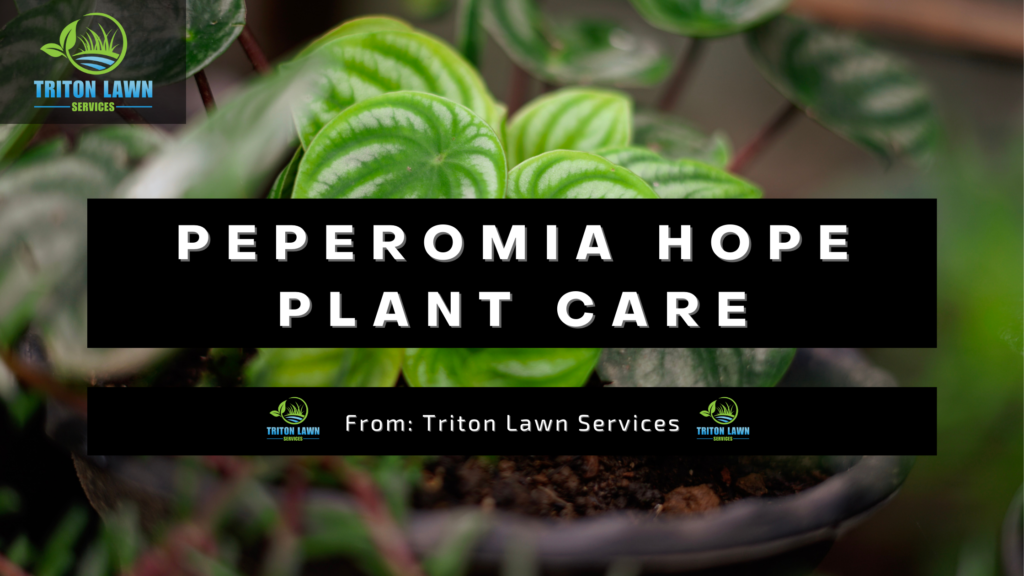peperomia hope plant care

From Triton Lawn Service
Peperomia hope [pep-er-ROH-mee-uh, HOPE] is a hybrid between peperomia quadrifolia and peperomia deppeana.
This perennial epiphyte has beautiful foliage and makes ideal houseplants.
Originally from tropical regions of Central and South America, peperomia plants have eye-catching leaves and a tolerance for a wide range of conditions.
Belonging to the Piperaceae family, peperomia has its name derived from Greek words peperi (pepper) and homios (resembling), referring to its resemblance to a pepper.
Unlike most succulents, peperomia prefers more water and higher humidity.
Its trailing soft stems, delicate leaves, and small fleshy leaves make it ideal for hanging baskets, dish gardens, or potted indoor house plants.
Since they have a compact form, they easily occupy small spaces.
While there are more than 1,000 types of peperomia plants in the world, not all of them are cultivated for the public.
Some of the most common types of peperomia plants are:
Peperomia rosso is an attractive sport of Peperomia Caperata with rippled leaves and burgundy color.
The watermelon Peperomia (Peperomia argyreia) has eye-catching silver stripes across its elliptical shaped leaves.
It rises up to 8″ only if planted in a container.
The baby rubber plant (peperomia obtusifolia) has solid green and shiny leaves.
Some types are variegated with gold and white coloration.
A dwarf specimen, Peperomia obtusifolia ‘Minima’, is a little plant and reaches half the size of the standard peperomia hope plant.
Most gardeners recognize peperomia hope by its common name of radiator plant.
Peperomia Hope Care
Size & Growth
For beginners, peperomia hope is an ideal houseplant to grow. It requires little care and can tolerate some neglect.
It’s a small plant and grows up to 8″ inches across and 12″ inches high. Its compact size is what makes it perfect for dish gardens or desktops.
Peperomia hope doesn’t spread vigorously or overtake neighboring plants.
Flowering and Fragrance
Peperomia Hope has ornamental foliage and the flowers are insignificant.
It has a year-round bloom time and happily grows in different types of conditions.
Their eye-catching appearance also makes them perfect for a window container or terrarium.
Light & Temperature
Although they dislike the dry air, they grow pretty well in a cool environment.
The ideal temperature for its robust growth is between 65° – 75° degrees Fahrenheit (18° – 24° C).
They thrive in a medium to a low light situation.
For better results, keep them away from the direct sunlight. Bright light has a tendency to wash out the attractive leaf color.
You may grow them under fluorescent lighting or other forms of bright indirect light as well.
These plants are hardy to USDA hardiness zones 10 to 12.
Water Requirements and Feeding
During the growing season, make sure to keep the soil moist. However, you don’t want the soil to be soggy.
In the fall and winter, don’t water the plant until the soil is dry.
Peperomia hope or peperomia prostrata doesn’t respond well to overwatering.
This is why it is important to wait until the soil is dry. Watering every 7 to 10 days will be enough.
Use a balanced liquid plant food to deal with the new plant’s feeding needs during the growing season and fertilize bi-weekly.
You may use controlled-release fertilizer pellets as well.
Do not fertilize the plant during winter.
Soil & Transplanting
The plant grows well in a look, well-drained, very rich potting soil mix with a ph of 6 to 6.6 (50% peat moss/ 50% perlite).
NOTE: Always use a pot with drainage holes.
While they don’t generally require repotting, it is better to report them when they become too large for the container in which they were initially planted.
For best results, grow the plant in a light porous soil mixture with part perlite to make sure the roots receive ample air circulation.
Grooming and Maintenance
One of the highly sought-out indoor plants, peperomia hope requires some pruning.
When the light green leaves on the trailing stems start outgrowing its container, it is time for some leaf-cutting.
In spring, repot the house plant to refresh the soil.
Keeps the plant in a small pot as they generally like small spaces.
If you want to change the container after repotting, don’t go more than one pot size up.
How to Propagate Hope Peperomia
The easiest propagation method for Peperomia hope is through the use of leaf cuttings.
Remove the large succulent leaves with their petioles and plant them in fresh soil.
Place the container in a warm place with indirect light and don’t change the location until new growth emerges.
Peperomia Hope Plant Pest or Disease
Hope Peperomia plants are vulnerable to a few pests and diseases.
When light is too strong, the plant will have fading dull leaves.
The remedy of this problem is simple as you’ll have to move the plant to more shade.
If the plant is facing the problem of overwatering, it will start showing discolored leaves and flowers.
For this, make sure to water the plant when the soil is dry.
Overwatering also causes scab-like protrusions on the plant’s leaves.
Peperomia Hope Use
Use the compact-sized Peperomia Hope plant for decorative purposes inside and outside.
It looks great kept on a desktop or a windowsill.
